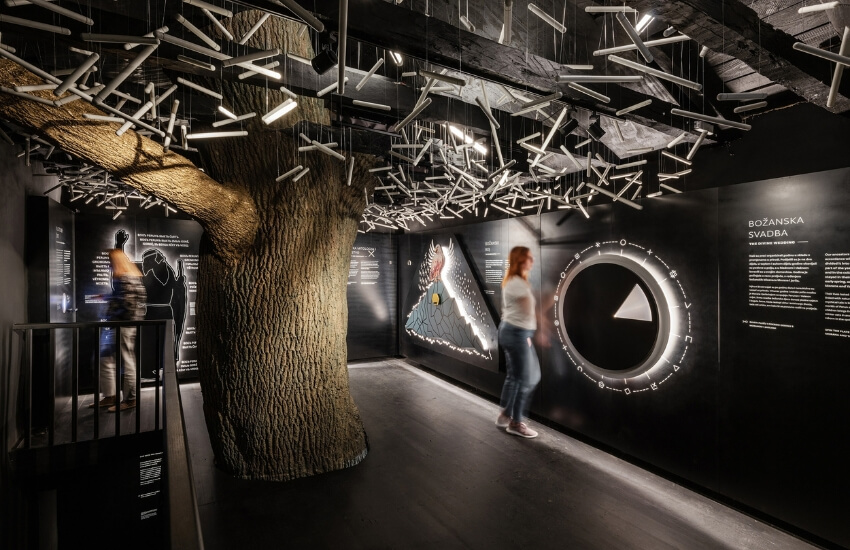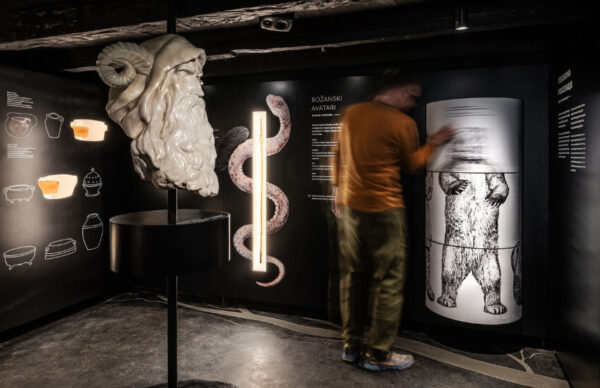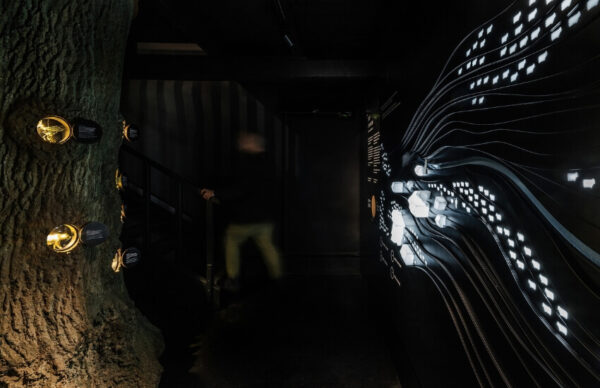
House of The World Tree Trebisca: A Journey into Myth and Nature

Internationally acclaimed studio, Rašić+Vrabec, has earned a reputation for experiential design that transcends boundaries. In this interview, Marko Rašić, one of the founding partners, shares the vision behind House of The World Tree Trebisca – a unique eco-museum that interprets ancient myths through minimal, human-scale interactivity.
Award: Best of Best 2024 / Exhibition Design / Museum Exhibitions
Project: House of The World Tree Trebisca
Firm: Rašić+Vrabec
Lead: Marko Rašić, Vedrana Vrabec
1. Can you share a brief background about Rašić+Vrabec and how your experience has shaped your approach to design?
Marko Rašić: Our internationally acclaimed studio, Rašić+Vrabec, specializes in experiential design. Founded by partners and designers Vedrana Vrabec and myself, with over 20 years of experience, the studio has earned numerous prestigious awards, including SEGD, Red Dot, Graphis, BigSee, C2A, Wolda, Art Directors Club, European Design Festival, D&AD, and more.
We take a holistic, ecological, and socially responsible approach to every project. Museum design has allowed us to meet people from all kinds of business, scientific, cultural, and social circles. By collaborating with these diverse individuals, we’ve realized that it’s not the project that matters, but the Person—the human is at the core of our work.
2. What was the brief for House of The World Tree Trebisca, and what were the key objectives?
Marko Rašić: This interactive exhibition interprets the ancient myth of the coexistence of man and nature through scientifically processed proto‑Slavic beliefs and deities in the Istrian region. Nestled in the stunning landscape of Mount Učka, this unique eco‑museum is accessible only on foot – a truly special location where visitors, after exploring the exhibition, can rediscover the beauty of nature with a new perspective.
What makes the exhibition special is its minimal use of high technology; interactions are primarily mechanical, requiring body movement or the pressing of buttons.

3. What inspired you to design this exhibition?
Marko Rašić: The main motif inside the house is a sculpture of an oak tree, symbolizing the ancient Slavic cosmos. For inspiration, we studied over a hundred oak trees in the vicinity of Zagreb and the Kvarner Gulf. During our exploration, we discovered some lesser‑known magical natural moments – such as the oldest downy oak tree in Croatia on the island of Krk and “Dedek,” a nearly 600‑year‑old oak in Zagreb’s Maksimir Park. This monumental tree served as the main inspiration for the sculpture.
The highlight of the exhibition is a spatial interactive installation of a treetop, inspired by the exhibition’s visual identity, which reveals the connection between ancient Slavic deities and our world. As we worked on site, several hikers passed by and shared their amazement, which confirmed that our design had struck a magical and transformative chord.
4. What challenges did you face during the production of this project, and how did you overcome them?
Marko Rašić: The production of this project was extremely demanding due to the difficult‑to‑access location. All interior design elements, exhibits, and sculptures had to be transported by adventure quads and assembled on-site. There is no internet access or even a phone signal there, making communication nearly impossible—something that seems almost unthinkable today. Visitors are completely cut off from the world while in the museum, an aspect that is both convenient and deeply meaningful.

5. How has your passion for design influenced your work, particularly in creating immersive experiences?
Marko Rašić: The person is always at the center of our approach – from the client-designer relationship to the final museum-visitor or product-customer relationship. Relationships build a quality project and a strong brand. One must strive for someone or something; you don’t exist solely for yourself. Even an artist ultimately works for the audience because they want to exhibit their work and receive feedback.
The final product of our exhibition design is the design of the experience, through which we convey the essence of the story to the visitor. The richness of diversity is integral to our way of working – our journey started with graphic design (books, catalogues, visual identities, posters) and quickly evolved into spatial graphics, exhibition stands, and complete visitor experiences. What connects it all is art and ecology. Designing an exhibition place is a complex process that involves product design, graphic design, multimedia design, lighting and interior design, interpretation, and production – and ultimately, no photo or video on screen can replace the immersive experience of visiting in person.
6. How do you view the role of AI in creative processes, and what impact does it have on your work?
Marko Rašić: AI has no soul and never will. It is simply a tool, and like any tool, it’s most helpful when used correctly. We are currently seeing excellent improvements within existing software tools, but manual human refinement is still essential to make something generated truly meaningful.
7. What steps do you take to continue growing as a designer?
Marko Rašić: Learning, learning, and more learning! I grow through work, experience, and interpersonal relationships and communication.
8. What inspires your imagination, and how do you nurture creativity day-to-day?
Marko Rašić: People and Nature! We should always return to our roots and respect what has been done before us, as that is the only way to achieve authenticity. Everything else leads to unnecessary information overload and pollution.
9. Who are your biggest influences or the creatives you admire most?
Marko Rašić: We strive to look up to great storytellers in general – whether they are writers, movie directors, painters, psychologists, neurologists, philosophers, or inspiring individuals from any profession. We learn from art history and the practical solutions of our ancestors. Given today’s vast resources and rapid pace, comparisons with contemporaries via competitions and awards are more important than ever.
10. How do you balance client needs with your creative process?
Marko Rašić: For us, design is always the result of the very same process where our personal style is not the focus. What truly matters is the relationships we build with clients – how we approach them, listen to, and respond to their needs. That dynamic creates the solution: our design. Perhaps one day someone will conclude that we have a particular style, but we don’t concern ourselves with that.
11. How do you feel about receiving a Creative Communication Award?
Marko Rašić: It is a very relevant award and a recognition that puts us on the world map with others from our field. We see it as the result of great effort and teamwork, which validates our successful collaboration with our partners and clients. More importantly, awards provide excellent publicity to attract more visitors to the museum.

Unlocking Nature’s Magic: The House of the World Tree Trebisca Experience
The House of The World Tree Trebisca invites visitors to step into a magical journey through myth, nature, and art. This interactive eco‑museum, set amidst the stunning landscape of Mount Učka, redefines the exhibition experience by connecting ancient stories with modern ecological values, leaving every visitor with a renewed appreciation for the wonder of nature.

